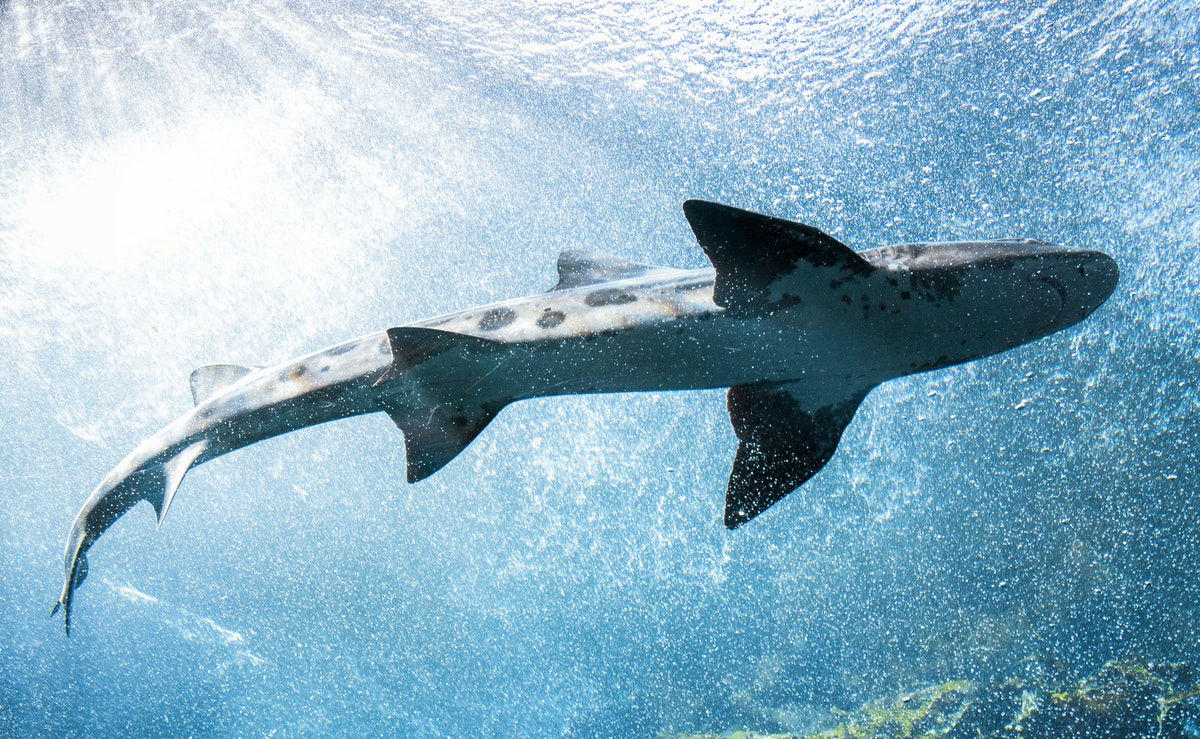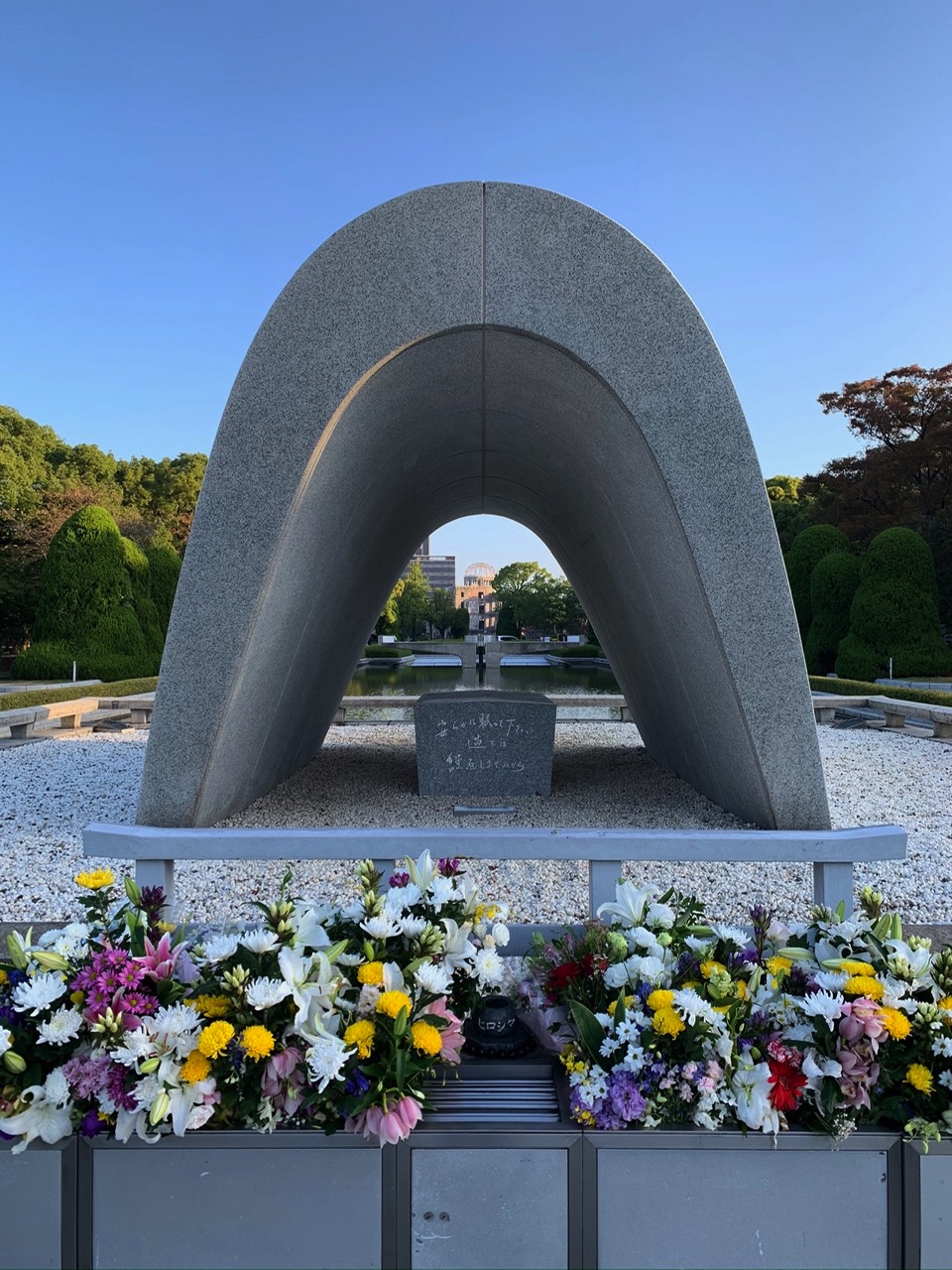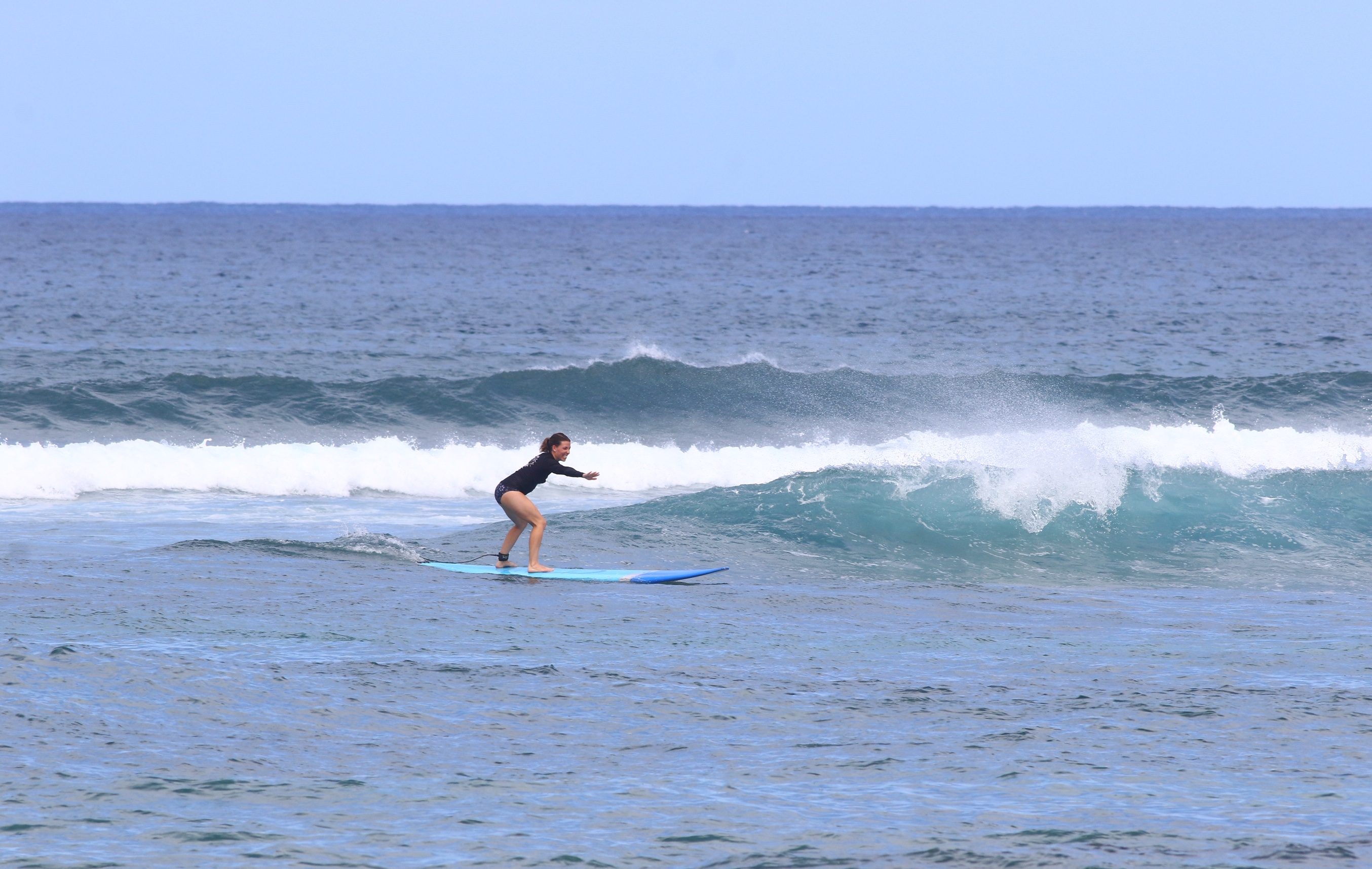I am currently 2,743 feet up in the air. The temperature is minus forty-five degrees Celsius, but I’m donning a sleeveless dress with black tights. We are on our way to Thailand and I am prepared for the thirty-five-degree heat. But I can’t leave Japan without a warm farewell, a sincere sayonara, and a further account of our experiences there.
We stayed in Japan for a total of eleven days, and spent time in Tokyo, Yamanashi (Mt. Fuji region), Hiroshima – including a day trip to Miyajima Island – Kyoto and Osaka. Our time in Kyoto and Osaka was admittedly short, about twenty-four hours each. How long does one need to stay in a place to get a sense of it? Not that long, it turns out.
While Tokyo was hit by a typhoon a few weeks before our arrival, the climate cooperated perfectly during our stay. The ongoing joke between Dan and I was him asking if we needed the winter coats I packed, as the thirteen degree overnight and brisk morning temperatures quickly rose to nineteen or twenty degrees during the day. You can’t say I wasn’t prepared.
Interestingly enough, we hardly needed any of our own clothes during our time in Japan, as we spent four days at a traditional ryokan (Japanese inn) where our attire was provided. From a laundry perspective, this was great news. The hotels we stayed at in the big cities also provided nightwear, aka pyjamas, but we opted for our more casual t-shirts and nightgowns versus the buttoned-up affair.
My impressions of Japan are a series of moments and small details: colourful paper cranes at the Children’s Peace Monument; matcha tea and gelatinous purple treats in the tea house of the rock garden at the ryokan, the sound of a bullet train whining past, like steel breaking the sound barrier; soaking naked in the onsen beside strangers on the roof and staring at Mount Fuji in awe.
Dan described Japan best with a simile. He said Japan is like an iPhone in that if you follow the system, not only do you get the most out of the experience, but it works, and it works well. If you try to deviate outside the norm, there is no flexibility, and you will spend a lot of time banging your head against the wall in frustration. We had our share of glitches in Japan. Nothing frightening or harmful, just the impracticalities of trying to operate under a different system. Of being an outsider.
Perhaps the most acute difficulty with trying to simultaneously figure out a new culture while living our lives was to also care for our children. I often advocate on children’s behalf promoting their ability to adapt to change more readily than adults – and this is true, to an extent. Children are also creatures of routine, and when those routines are significantly altered, chaos can ensue. Okay, in our case, no chaos ensued. Well maybe a little chaos.
The food was the most obvious deviation from our regular routines. Despite Japan’s international reputation as being one of the healthiest nations in the world, partly due to its intake of fresh fish, we struggled somewhat with our diets. In a pinch, Seven-Eleven proved to be a great take-out option, but the meals we procured weren’t necessarily complete or health-conscious. For example, for one of our last breakfasts, I grabbed a cooked hotdog in a bun, a few bananas, donuts (for Ariel, the picky eater), an orange juice, yogurt cups, hard boiled eggs, and an egg & ham sandwich with tomato (a very popular meal option found around the country). While the meal wasn’t un-healthy per se, it wasn’t exactly healthy either. At home, we try to limit our kids’ juice consumption, but in Japan, vending machines abound, we embraced it and tried to fill our kids up on juice more than once. To my surprise, we often found ourselves in restaurants serving udon noodles or ramen, that often also served fried chicken and rice. Those were the staple foods our family came to depend on (outside of our ryokan stay where we were fed like kings and queens). I previously wrote off western foods in Japan, but that’s just not true. There are more options in the bigger cities, you just have to know how to find them. Down the road from one of our Airbnb’s, we stumbled across a burger joint. Hamburgers and onion rings have never tasted so good, especially to Ariel who had been subsisting on dinner bowls of plain white rice.
On the eve of our departure, Dan and I finally said enough is enough and pointedly asked the hotel receptionist for a good place to get sushi.
“We can’t leave Japan without eating sushi!” Dan and I both reasoned, having eaten so little.
When I explained our desire for good sushi, the receptionist was resolute.
“Good sushi and cheap,” she promised me, pointing to a place close by on the map.
Well, we navigated the directions she gave us and found ourselves in a mall food court. Not exactly what we had in mind, but you can’t win them all. Much to my surprise, the food court sushi was sublime. We ordered seconds.
When we found ourselves in a pinch for food, and the kids were getting cranky, ice cream became the answer. Not only did we buy it for our kids en masse, but restaurant owners, those who took us under their wing, those who didn’t even sell ice cream, would give our kids their personal ice cream stash in an attempt to please them.
One afternoon, nearing the end of our Japan stay, we pushed our kids to their limits. They had reached a point of exhaustion for which there was no return. What happened next, I will fondly refer to as the ice cream incident. I am only able to detail the experience now, because we lived through it.
Dan and I rely on Ariel heavily to be the Big Sister, the mature one, the kid who gives us the least amount of grief. Whether this is fair to ask of an eight-year-old or not is debatable, but none-the-less, we have high expectations for her that include helping out, so when she shuts down, all hell breaks loose. On the day of the ice cream incident, Ariel lost her favourite pink sweatshirt. As it turns out, the sweatshirt got left behind on one of our shinkansen (bullet train) rides that day and with the sky overcast, a light drizzle falling, the air felt cooler. She was miserable and cold. Dan wisely refrained from making the winter coat joke. We had more than one long-sleeved shirt for Ariel, of course we did, but we had abandoned our luggage the day before and wouldn’t be procuring it back at the train station until later that day, so she was stuck with only a t-shirt – the first sore spot. Then, we happened to be visiting a “park”. When I say park in Japan, I mean a place where there is some interesting shrine or pagoda or monument. My kids assume playground. I have since learned – the hard way – to watch what I say. BE specific.
Ariel and the others anticipated “park”, aka “playground”. Instead there was a massive crowd and a whole lot of steps to walk up through beautiful, “boring”, wooden orange archways called Torii gates. Ariel was incensed. Elyse protested the crowds and was unsettled riding on Dan’s back in a carrier and Penelope refused her stroller, deciding instead to weave dangerously in and out of crowds of people, risking getting lost or injured. Her behaviour put me on edge, my mother instincts on high alert. Ariel protested her displeasure with her currently situation loudly, repeating the same complaints over and over, with a voice I’ve come to associate with her alter-ego, Exhausted Ariel. I should note, for posterity, that I also have an alter-ego we refer to as my “secretary”. I have the world’s worst secretary who absentmindedly speaks on my behalf, but doesn’t actually listen or pass on any messages or recall any important details of the exchange for real Adelle.
Exhausted, and now irate Ariel was in full swing. The difficulty in travelling as a family – if I were to put myself in the child’s position – is the inability to get away from each other for a break. Dan and I constantly have eyes on our kids, which is exhausting and draining for both sides. Nobody wants to be monitored constantly.
At one point in the steep walk, Ariel staged a showdown. This was it. She wasn’t going to walk any further. I coaxed her up to the top of the next set of steep stairs, at which point she accused me of grave lies, stating I had promised that would be the end of the hike. I had not – could not – make any such promise, having no idea where we were or where we were going beyond following the crowd. As a final straw, I had to implement one of the only respite techniques at my disposal to try and rally the troops – candy. I hate to say it, but with our kids getting whiny, candy has been a great way to either silence them at pivotal moments (think: Penelope bellowing Frozen’s Let It Go! at the top of her lungs in Hiroshima’s Peace Memorial Museum) or to try and tide over their hunger or displeasure in a given situation beyond our control. I hate that we have done this. We are not that parent, but then again, I guess we are. You do what you have to do. So, when a little further down the trail, hoping to regain regular Ariel and send Exhausted Ariel packing and I saw the ice cream stand, I offered my children ice cream.
I’d like to pause here to say that Dan and I have done our best to raise respectful, peaceful, grateful children. What follows is a shame and disgrace, but if I’m going to share our adventures, then I’m going to share them all.
There were two flavours of ice cream available for purchase: vanilla and green tea. In Japan, there are replicas of all the food out on display – very helpful – so right away, Elyse latched onto the idea of the green cone, pointing to it profusely, as did Penelope. Ariel, having a better grasp of the situation and her preferences, chose vanilla. So far, everyone is feeling good. Each girl knows she is getting what she asked for. Spirits are brightening at the prospect of ice cream. My plan is working.
Dan and I chose a hot pork bun and a milk tea latte with tapioca “pearls” to share, for the record, and that was the extent of the choices.
There was a small seating area carved out into the jungle for patrons of the small shop to sit with their ice cream. We took our places, and as the cones were prepared, a group of Spanish-speaking women joined us. They were grandmotherly and sought to make a connection with me, mother to mother, which I appreciated, but I was straining under the weight of my children’s needs.
In stark contrast to our children’s exhaustion and foul moods, was the chipper, helpful and industrious little girl working behind the counter taking our payment, counting out our change and serving our ice cream. She must have been the same age as Ariel, about eight.
I’ve tried to encourage my family to adopt a group mentality while traveling together. We do what is best for the group. As such, no one individual has true ownership over anything, if what is best for the group is to share.
The cones arrived, and predictably, ice cream can’t fix exhaustion, it can, however, apparently make things worse.
Elyse didn’t want the green ice cream cone she asked for. She fussed and complained loudly, letting out angry screams. This is a behaviour she engages in when she’s shutting down, frustrated and needing to be heard. Dan, in turn, lambasts me for letting her get what she wants because I should have known she wouldn’t really want the green one. His tiredness showing, having carried forty pounds of extra weight on his back for the last hour up hill, I wisely ignore his slight with a reproachful glance and turn my attention to Ariel’s cone. She will have to share. But Exhausted Ariel doesn’t share, she is understandably too intent on meeting her own needs. The Spanish-speaking women are impartial to Elyse’s screams; one woman says to me, “we’ve all been there before,” as I give her a weak smile in return. As the eternal optimist, even I can’t see this scenario getting better. In fact, it’s going to get a lot worse because now Ariel is complaining, LOUDLY, about having to share HER ice cream cone. She is beside herself. Her voice turns shrill and convalesces into an indiscernible whine. I’m cringing inside and out at the absurdity of my children arguing over ice cream. My cheeks burn at their privilege, at my ineptitude as their parent and embarrassment at the very publicized tantrum by two of my children, screaming at each other back and forth. The icing on the cake was not only could Ariel not bring herself to share any of her cone with her sister, but when Penelope’s cone became available, and Elyse was finally calming down to enjoy some of the last bites of the freed up cone, Ariel snatched it from her hand and Elyse wailed at the injustice. The Spanish-speaking women all sighed and turned away. As it turns out, we hadn’t all been here. I hated for my children – and admittedly myself – to be so exposed to the judgement of others for this subversive behaviour. To watch my children melting down in such a public forum. To add to my shame, as we were preparing to leave, the little girl who had served us the cones came out to offer our girls a cup of broken cones – as a sort of peace treaty. My girls were hardly in a state to show gratitude, but the Spanish-speaking women ate it up, with looks at me that conveyed, that’s how you parent.
I know sugar only makes things worse, but this proves it.
Dan and I packed up our kids, heads down, and continued on our way back down the mountain hoping not to run into anyone who had just witnessed our family catastrophe.
Not long after the ice cream incident, our kids made amends and were reunited in their shared pursuit of petting a shrine cat. Kids are good at forgetting and being in the moment. Dan squeezed my hand and shortly thereafter, we made our way out of the “park” and onwards to our accommodations, with no long-term ill-effects or family fallouts not reconciled. While there are challenging behaviours, I am definitely remembering to hug my kids close and enjoy our time together. Families that play together, stay together, but you have to expect a little rough housing every once in a while.
Ultimately, this story has a happy ending. Ariel’s pink sweatshirt was eventually returned to her, having been recovered from the train station’s lost and found and Exhausted Ariel was laid to rest. Elyse ate many other ice cream cones that she thoroughly enjoyed, none of which were green. Penelope stopped associating bad behaviour with candy, because I learned to disassociate the two, and Dan and I reconciled the tensions the best way adults know how, through more love, less talk. Japanese style.
And one more thing before I go. Did you know that in houses in Japan they don’t just have a shower, but an entire shower room? That it’s customary to remove shoes at the entrance of a home and wear slippers? That there are separate bathroom slippers? That hotels provide sleepwear? That several public bathrooms don’t have soap dispensers? That there are no trash cans anywhere, but it’s not dirty either? That in Hiroshima, you can’t book a taxi before 7:30 a.m.? That our family of five required two taxis with our luggage – and that taking the train or public transport is usually the best option to get around? That Osaka, the city of our departure, has a population almost equal to the size of Canada in its entirety?
That on our flight to Bangkok, we would be served ice cream. And that, predictably, while Dan was out at the bathroom, Ariel would ask the flight attendant for seconds – and seconds would come! I’m shaking my head. What I didn’t know, is that Dan had already given Ariel his ice cream cup. Thirds it is, and many more fun parenting moments ahead.











